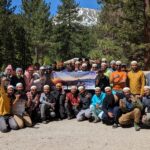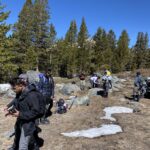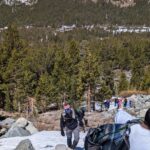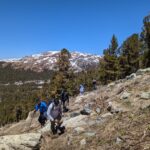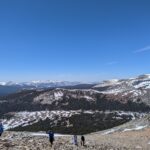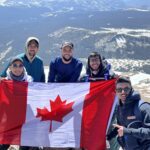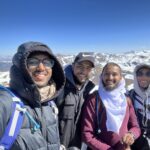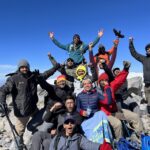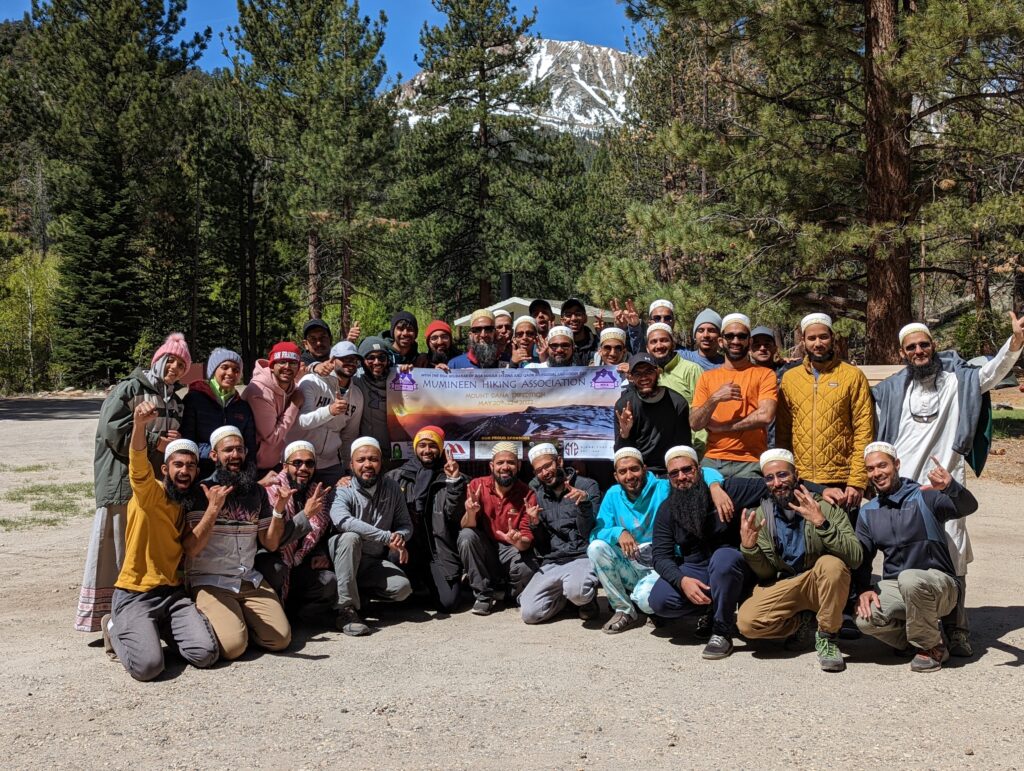Mumineen Hiking Association 1445
Frequently Asked Questions
Mount Shasta 2024
Frequently Asked Questions (FAQ)
Summary
Mount Shasta is the second-highest peak in the Cascades and the fifth highest in California. Climbing Mount Shasta involves dealing with altitude, weather changes, and carrying everything you need for the climb. It’s a true mountaineering experience, demanding preparation and respect for the mountain’s conditions. While challenging, it promises a rewarding adventure for those who come prepared.
The Shasta Experience
This year, we’ve heard a lot of different feedback and plan to incorporate it to make the hike most enjoyable for all. Here’s what’s different this year:
- Backpacking
- This year we’re pushing the pace by adding a new element – backpacking. Typically, we’ve done day-hiking where we camp separately and only take up a small “daypack” on the mountain. This year – you’ll be taking “full pack”, a 50L+ backpack with the capacity to hold 2 nights food, water, sleeping gear, and everything else you need to survive in the wild. Full packs look and feel different, are significantly heavier, and pose a new challenge.
- MHA Rent Option: These are typically pretty expensive, and you’ll also need a compressible sleeping bag, pad, tent, jet boiler, and more. You’re welcome to buy/rent your own gear and bring it but it typically costs quite a bit. In order to make it easy to come – MHA will help you rent them from a local outdoor supplier at cost. We recommend you buddy up to share the tent – here’s the approximate cost for two people – LINK HERE.
- Splitting the weight: Two friends or similar size and weight OR spouses may be able to split one full-pack. 1 person can carry the pack, tent, bags, and pads – while the other carries food and other goods in a smaller daypack.
In this model, you can rent a 1 person kit – but you’ll need to acquire a – 2-person tent and find an extra compressed bag and pad. They MUST STICK TOGETHER at all times.
- 2 Experiences
- The first day of hiking on Saturday will not be too difficult. It’s about 3-5 hours to the Clear Creek Campground, where we’ll set up tents, cook our food, and sleep the night. If we leave around 9AM – we’ll reach by 2pm with plenty of time to rest, set-up, take in the views, and relax. You can continue hiking up and exploring, come back down, sleep the night, wake up the next morning in a relaxed manner, pack up camp, and head-on down.
- Summit Option: For those who are willing to summit – we’ll have to be up around 4AM or earlier, and start up some of the toughest, steepest terrain there is. It’ll be a grueling slog for at least 6-8 hours before we get to the top and then we’ll have to start down. This mountain is no joke – just look at AllTrails yourself. Once we get back to Clear Creek, we’ll break camp and head down to the cars to drive home. It is a scree mountain, there will be winds, steep slopes, and a long path up. But for those who make it, you’ll add a third MHA peak to your record. You ready for this?
- Accommodation
- To make it easier the first night and based on your feedback from last year – we’ve kept Friday nights accommodation in a hotel so everyone can get a good night’s sleep and be ready for the day tomorrow. There aren’t too many feasible campgrounds, and the other options are will be too much work before tackling a mountain like Shasta. We’ll need all our energy. However, that means we’ve increased our registration fee to $150 to account for it.
- Finances
- You’ll need to account for a bit more this year. Here’s the breakdown:
- $150 – Registration fee (includes your transport and accommodation)
- ~$130 – Backpacking Rental
- ~$150 – Airplane Ticket (if necessary)
- $50 – Food and other expenses
- Total: $480
- You’ll need to account for a bit more this year. Here’s the breakdown:
Training
- How should I train for this?
To prepare for the 12-mile round trip hike of Mount Shasta via Clear Creek, regular aerobic exercise and HIIT training are recommended for a month leading up to the hike. This training helps acclimatize the body to lower oxygen levels and improve endurance. Additionally, strengthening the quadriceps and legs through weight training is beneficial. Remember to phase out the routine and begin stretching a few days before the hike to avoid soreness.
- I came last year to Mount Dana and White Mountain. Is this much harder?
We’re glad to welcome you back to MHA’s third year, White Mountain was a blast! At 14k feet, you got a good taste of what the highest elevation in California is like. We’re going to go to the same elevation this time, but much different terrain. I’m sure you all remember the surprises we had on that trip – so you’ll be extra prepared on this one. Mount Shasta is a shorter hike, but the elevation gain is grueling – so anticipate this being more of a stair-stepping challenge then the relative flatness that Dana was. Train for slow, steady steps. Learn the sherpa step. Mount Shasta is in another league, both in terrain, hiking style.
Because we will be backpacking, this will also be a completely different experience. You will be carrying around 30 pounds on top of your own body weight carrying your pack with you, train for this! Weighted squats is a must here if you want to be attempting this. Do some practice runs with weighted bags, you will need to learn how to walk with a pack. It is very different from just a day hike.
- How hard is this going to be? Should I be scared? Am I fit enough?
As this is our third MHA climb, we decided to up the ante a bit and choose a hike that helps uplevel people but is still a manageable hike.
Here is a video demonstrating the hike. It will allay most of your concerns.
Altitude
- How high is this mountain, like really?
Precisely? 14, 180’
- What is altitude sickness or Acute Mountain Sickness (AMS)?
As you climb in altitude, the relative amount of oxygen in the air as a factor of the air pressure decreases, and you absorb less of it. As a result, the necessary amount of pressure to sustain mental and physical alertness decreases. At very high altitudes, from 11,500 to 18,00 ft. the arterial oxygen saturation (SAO2) falls below the 90% necessary line, and as a result, mountain sickness, which at its lowest is AMS, and it’s highest can result in stuff we don’t wanna scare you with.
Didn’t make sense? Basically, the higher you go, the less oxygen there is, and it makes it harder to move and can make you dizzy, give you headaches, and vomit. There’s nothing you can really do but see how it affects you, and we’re requiring Diamox ®, to help prevent this. Don’t get too scared, safety is above all else for us.
Gear
- What do I need to bring?
Because of the stark change of plans, we will be providing backpacking backpacks, tents,
and sleeping bags. You are still required to bring the gear list here. We will re-pack this
Into the bags we provide.
- What’s the tenting situation?
We will be camping around 9200’ at the Clear Creek Campground. We will be using the tents that we have provided.
- What’s my investment looking like?
Well as you know, we don’t charge to organize the hike :), so zilch there. You’re going to pay for your flight ticket, say $250-$300. The $250 for registration is to cover the cost of transportation to the mountain ( we’re renting 4×4’s, cause it’s going to be a bumpy ride) which is about $100 due to inflated gas prices. We will also be providing full packs, sleeping bags, and tents as part of the backpacking adventure. We’re also going to provide basic snacks, some food, and tents. You’re going to have to pay for food that we buy in civilization (further details under the food tab), say $100. Grand total of non-gear items: approx. $700.
We’re gonna assume you have most of the stuff on the list, because they’re pretty common things to have. However, things get old or broken, or there may be a couple gaps, so let’s say $100 to buy new stuff. If you have last years stuff, great, you won’t need this.
Grand total: $700-800 for your entire adventure.
*This figure is an estimate intended to help you gauge your financial ability to come. Please do not take it at face value, and expect fluctuation to occur.
Guidance / Rangers
- Who will help and guide us on the hike?
MHA wil be guiding the hike, captained by our seasoned mountain rangers. Most everyone on our team has done 5-10 combined ascents of various different mountains and been through a lot together. We’ve seen crazy things and have a good idea how to prevent them – so hopefully you never have to.
Rangers have the final say on route, time to ascend, descend, and fitness assessment. On the mountain it’s critical to listen to what they tell you and take it seriously. We want this hike to be safe and listening to your rangers is the best way to make sure you get up and down safely.
- What if I get too tired? Will someone carry me?
No one will be carrying you if you get too tired. You’ll have to stop, recuperate your strength, and start back down. The cardinal rule is – “Climbing up is optional, but climbing down is mandatory”. That’s why it’s very important to train seriously for this hike – you don’t want to be a burden on anyone.
- What if I get hurt?
We’re taking every precaution to make sure this doesn’t happen – but in the case that someone suffers an injury on the hike, MHA will assist in every way we can. Our goal is to make sure you get up and down safely. We don’t take personal responsibility for injury to anyone.
- If you are mobile – you’ll be slowly helped down the mountain by a ranger or another veteran hiker whose been given a communications device.
- If you are immobile:
- A team of rangers will work to help escort you down the mountain.
- A chopper, or park-assisted stretcher rescue will be called in if it is possible.
It is incredibly important that all hikers know: the park MAY NOT BE ABLE TO ASSIST INJURED HIKERS. That’s why you must:
- NEVER hike alone
- NEVER hike at night without guidance
- KNOW your limits
- AVOID unsafe areas and climbs
- LISTEN to your rangers
Accomodation
- When should I come in?
We’re leaving from our meeting point in Fremont at 12PM. If you want to come in early Friday morning, that’s fine, and you can wash up at someone’s house and go straight to the rendezvous.
You can arrive anytime Thursday as well, and we will arrange for you to be picked up from the airport, and will give you utaro with one of our awesome Fremont Jamaat families. If you are planning on coming in earlier then Thursday, please let us know.
- Where will I stay?
You’ll find Fremont to be very hospitable! We’ll give you utaro before and after the hike, Thursday night and Sunday night. If you plan on staying for longer then these dates, (You’re in California, there’s endless things to do and see :)), let us know so we can arrange it properly.
- When will I get my utaro information?
Someone with the MHA planning committee will reach out to you with that info before you arrive, as we get closer to the date we’ll be in contact.
Food
- What food do I need to bring?
So this is what our food map looks like
Friday – At night we’ll eat in civilization so no need to worry about food there. If you feel hungry afterwards at the campsite, we’ll have snacks and water, and you’re welcome to bring your own.
Saturday – Early morning, we need to leave for the trailhead from the campsite, so breakfast will be quick. You can wake up earlier and eat a Backpacker’s Pantry breakfast by heating water (my personal favorite – available at REI), or just some quick granola bars and water. We will provide basic snacks.
On the mountain is where things get tricky. You will have to carry all your food up with you and it adds a lot of weight. When you’re climbing, and especially with the altitude, your body will change. You will find that you don’t need as much food as you normally would, and mostly just things like candy, jerky, gatorade, trail mix, granola bars, dried fruit, will be all you reach for. Most first-time climbers have a tendency to overpack food, taking entire MRE’s and full lunches, and they have to lug that food around for the whole hike. We recommend the bolded items, a 3 liter water bladder (I like to load mine with gatorade powder), and extra water bottles.
This is where things change from previous years. We will be sleeping on the mountain at the Clear Creek Campground at 9200’. You will have to bring food that will be sufficient for you in the evening. Think cup-of-noodles, beef jerky. This won’t be lush, this will help you survive.
Sunday – We’ll start the day with some chai biskut, and then head to town for food at IHOP/Denny’s!
The Rundown
DAY 1 (FRIDAY):
Drive to McCloud and get into hotels. We will be setting up our packs and getting the best rest, because the next 2 days will be grueling!
DAY 2 (SATURDAY):
Wake up at 5AM and drive to the trailhead. We would like to emphasize that in the morning, we need to leave at 5 sharp, so there won’t be any time for “chai biskut”. Arrive at the trailhead at 7AM, and ranger groups can start heading out by 7:15. The hike to the Clear Creek trailhead generally takes 6 hours, so we expect groups to get to the campground by 2-3pm. We begin setting up our tents, and generally hunkering down for the evening, because we start early the next day!
DAY 3 (SUNDAY):
Wake up at 2AM and begin the ascent to the summit. This summit attempt will take roughly 14 hours. We will leave our packs at the Clear Creek campground and then summit, picking up our packs on the way back down. And then another 3 hours to come down. We will have dinner in McCloud at a Mexican restaurant and drive back to your point of arrival (Bay Area, LA, Bakersfield, or Las Vegas).

